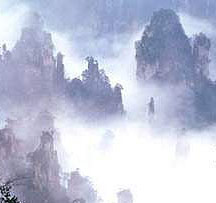
Mount Huangshan, towering between Taiping and Shexian counties in Anhui Province, is one of the most famous scenic spots in China, and perhaps the world.
With a circumference of 250 kilometers, it consists of 72 distinct peaks, the highest being Lotus Flower (Lianhua) Peak (1,800 meters). Mount Huangshan is every scenic mountain rolled up in one -- it is as lofty as Mount Taishan, as precipitous as Mount Huashan and as charming as Mount Emei. It can be blanketed in clouds like Mount Hengshan and has clliffside springs like those of Mount Lushan. Xu Xiake (1586-1641), the well-known geographer of the Ming Dynasty, extolled the beauty of Mount Huangshan in these words: "It is not worth seeing other mountains of you have been to the Five Great Mountains; and it is not worth seeing the Five Great Mountain if you have been to Huangshan."
The pines with their fascinating shapes, the rocks with their strange contours, the sea of mist and clouds, and the hot springs -- these are the four wonders of Huangshan. Many of the pines on the mountain have their roots deep in rock crevices; the famous Welcoming Guests (Yingke) Pine is representative of these hardy trees. The temperature of the mountain's hot spring-water is around 42℃ throughout the year. Clear and sweet, the water is ideal for drinking and bathing.
Tourists should not miss a visit to North Sea, (Beihai), West Sea (Xihai), Celestial Capital (Tiandu) Peak, Jade Screen (Yuping) Tower, and Cloud Valley (Yungu) Temple, which are among the prettiest sights on Mount Huangshan. Cool (Qingliang) Terrace is the best place for watching the sunrise and the clouds.
Huangshan's charm has drawn many distinguished travelers, including poets, writers, and painters of various dynasties, and tourists continue to flock to this legendary mountain all the year round.
Address: Huangshan Scenic Area, Huangshan City;
Entry ticket: 120 yuan (March 1 to November 30); 200 yuan (December 1 to end of February);
Tel: 0559-5562258.
Other Tourism Information
-- Places and Times to Watch Sunrise
Places: Shuguang (Morning Glory) Pavilion; Qingliang (Cool) Platform; Shizi (Lion) Peak; Danxia (Red Cloud) Peak; Shixin (Beginning-to-Believe) Peak; Qishi (Chess and Rock) Peak; Gongyang (Merciful Light) Mountain; Guangming (Bright Light) Peak; Bai'e (White Goose) Range; Shisun (Stone Bamboo Shoot) Peak; Yuping (Jade Screen) Peak; Lianhua (Lotus Flower) Peak and Tiandu (Celestial Capital) Peak.
Times: Spring and winter: 5:30 to 6 AM; Summer: 4:40 to 5:10 AM; Autumn 4:50 to 6:20 AM.
-- Best Time to View Sea of Clouds
The best visibility is between November and the following May after rain or snow fall, and clouds are most colorful at dawn and dusk.
(China.org.cn)
|

